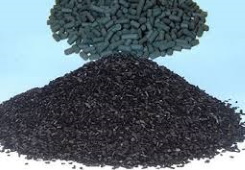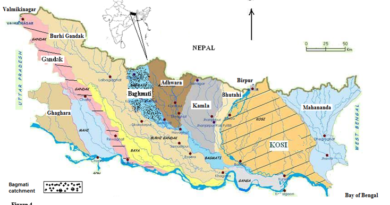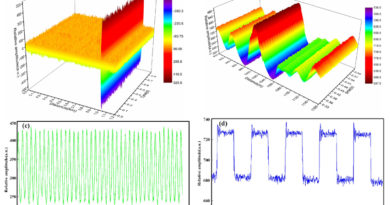Synthesis of Carbon flakes from Castor Seed Precursor
Rohit Kumar1,2, Ajoy Kr. Choudhary2, Maheshwar sharon1, Madhuri Sharon1
1 N Shankaran Nair Research center Jambhulphata Ambarnath (W)
2 Department of Botany and Biotechnology, T.N.B. College, T.M. Bhagalpur University, Bhagalpur, India
Abstract:
Castor seeds are non-edible oil rich plant product, with many medicinal properties. Carbon micro-flakes being a new type carbon material were synthesized from castor seeds (as precursor) by pyrolysis. During pyrolytic condition, Argon gas was used as carrier gas, and temperature was mentioned at 8000C for an hour. Scanning Electron Microscopic (SEM) images confirmed the morphology of micro sized carbon flakes along with some nano-carbon fragments. RAMAN spectra of carbon-flakes revealed the presence of defects on its surface thus confirming its amorphous nature.
Keywords: Carbon nano materials, Castor seeds, Pyrolysis, SEM, RAMAN spectroscopy
*Corresponding Authors,
Email: chaoudharyakbot@rediffmail.com
Introduction:
Castor bean (Ricinus communis) seed is an important drought-resistant shrub. It belongs to the Family Euphorbiaceae (Akande et al., 2012), monotypic genus, Ricinus, and sub-tribe, Ricininae(Phillips et al, 1999) which is indigenous to the south-eastern Mediterranean Basin, Eastern Africa, and India but it is wide spread throughout tropical regions and widely grown elsewhere as an ornamental plant (Phillips et al., 1999). Castor seed is rich of castor oil which has a wide variety of uses. The seeds contain 40%-60% oil that is rich in triglycerides, mainly ricinolein. The seed contains ricin a toxin which is also present in lower concentration throughout the plant. Castor bean seeds are highly toxic to human and thereby, they are non-edible.
Use of plant derived products like camphor, oil, non-edible plant parts, resin etc as precursor for the synthesis of Carbon Nano Material (CNM) have been made earlier [Sharon et al., 1998]. Plant derived products as well as plant tissues contain oil, carbohydrate, protein etc which are rich source of hydrocarbon. There are several reports on the preparation of Carbon Materials (CM) from agro-byproducts or wastes, which include corn straw (Lanzetta et al., 1998), peach stones (Tsai et al., 1997), grape seeds (Savova et al., 2001), cotton stalk [Putun et al., 2005], cherry stones (Savova et al., 2001), peanut hull (Girgis et al., 2002).
In recent years, novel carbon materials have attracted considerable attention because of their novel morphology and also specially physical and chemical properties, such as carbon micro-trees (Ajayan et al., 2000), mesoporous carbon (Álvarez et al., 2008), carbon nanohorns (Yang et al., 2007), coin-like carbon materials(Yuan et al., 2007), carbon sphere (Xu et al., 2007), and so on. Carbon nano-flakes as a by-product of synthesized carbon nano-tubes were first reported by Ebbesen and Ajayan in 1992 (Ebbesen et al., 1992). Carbon nano-flakes have been prepared by novel synthesis methods for their application in past several years(Wu et al., 2012).
In the present investigation, we have attempted to synthesize carbon nano and micro flakes from castor seeds used as a precursor by using Chemical Vapour Deposition (CVD) method.
Materials and Methods:
Precursors used were seeds of Ricinus communis (Castor), wereprocured from local market. Seeds were washed with distilled water (DW) and dried in an incubator at 600C for 6 hrs and then powdered in a mortar and pestle. Powder was stored till further use at room temperature.
Pyrolysis set-up: Single zone CVD furnace was used for pyrolysis of seeds. Quartz tube placed inside the furnace was used as a reactor. A flow meter was used for controlling the flow rate of carrier gas and bubblers were used for preventing the back suction into quartz tube during pyrolysis.The schematic of CVD set-up is presented in figure -1. Known amount of the seed powder was taken as precursor into a quartz boat for pyrolysis.To make the furnace oxygen free Argon (Ar) gas was used. Pyrolysis was done at 8000C temperatures for 1hr duration.
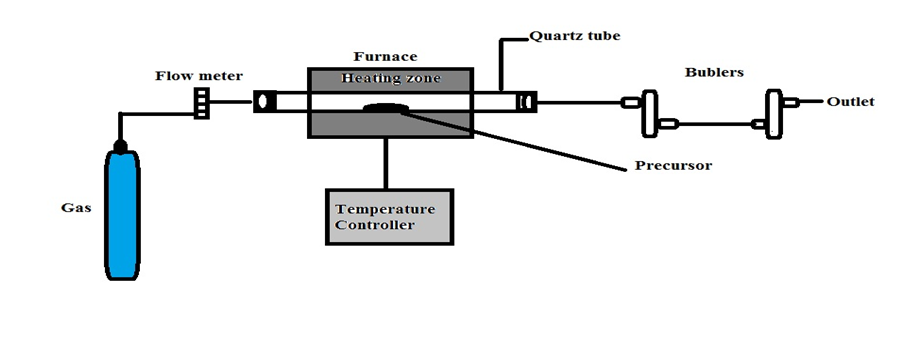
Figure- 1: A Schematics of Single zone CVD Apparatus
Pyrolysis of seed powder: 5 g crushed seed powder was taken in a quartz boat and kept inside the quartz tube then both the ends of furnace were closed. The desired carrier gas was purged purging inside the quartz tube at high flow rate (150 ml/min) for 15 minutes to remove the oxygen. Then gas flow was continued at slower rate (25 ml/min) during pyrolysis. After purging, the desired pyrolyzing temperature and duration of pyrolysis was set. Once the pyrolytic reaction was over, the furnace was allowed to cool down to room temperature. The pyrolyzed carbon material was subsequently collected from the boat.
Purification of carbon: Lumps of carbon collected from the quartz boat were powdered for acidic purification (Shingo OKUBO et al 2004). to get rid of any metal or other residual materials. Mixture of carbonized seeds and 6 M HCl were thoroughly mixed and were kept for 2 hrs, and then filtered. The powder was then dried by keeping at 600C for 6 hrs. Dried powder was stored for further investigations.
Characterization of carbon flakes:
Synthesized materials were characterized through SEM imaging and Raman spectroscopy.
SEM Image of carbon flakes obtained from castor seeds:
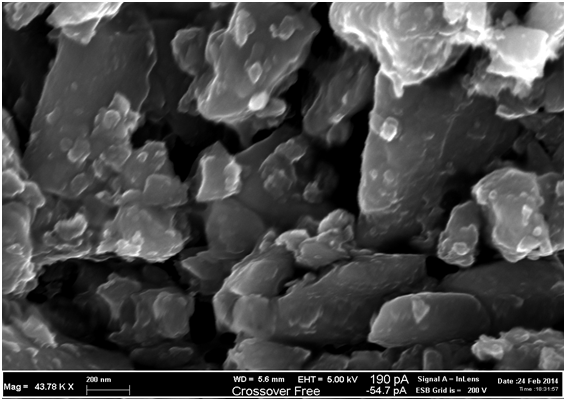
Figure- 2: Schematic of SEM Images showing Carbon Flakes from Pyrolysed Castor Seeds
The synthesized material exhibited flakes like structure in SEM image (figure 2), there were mixtures of nano and micro sized flakes of carbon material. The thickness of the flakes was recorded to be in the range of
approx 100-1000 nm.
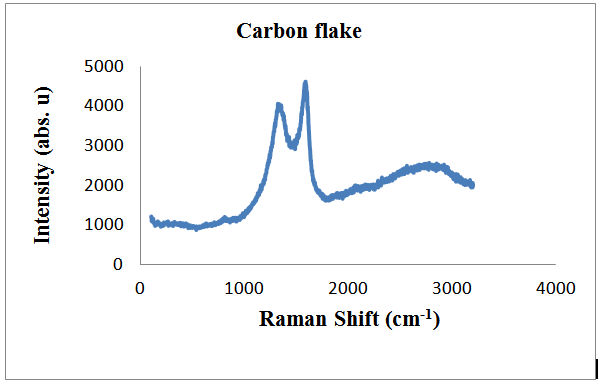
Figure- 3: Raman spectra of carbon flakes obtained from Pyrolysed castor seeds
A Raman spectral analysis of carbon flakes obtained from castor seeds confirmed that the carbon obtained was of graphitic nature (figure 3). Sharp and intense Raman peak of G-band observed at 1591cm-1 with respect to the peak of D- band at 1359 cm-1 showed the presence of CNM in the form of flake like structure. An additional broad peak at 2815 cm-1 explains the sp2 hybridisation pattern; this feature corresponds to the overtone of the D-band. It is the 2nd order two phonon process but sometimes clearly seen in the Raman spectra. A ratio of intensities of ID/IG was calculated to be 0.884, which denotes the presence of graphitic nature and purity of Carbon flakes. Defects in graphitic materials are important for improving the performance of carbon-based materials for practical applications.
Conclusion:
The Carbon flakes from biological precursor (castor seeds) have been synthesized by single zone chemical vapour deposition (CVD) furnace, which is an inexpensive source and the method can be further scaled up making it more viable way for obtaining bulk material of carbon flakes.
Acknowledgment:
Authors wish to acknowledge the financial support provided by the authorities of nsnRc,SICES, Ambernath and specially Mr. K.M.S. Nair and Mr. K.M.K Nair and specially thanks to P.G. Deptt. of Botany, T.M. Bhagalpur University for laboratory.
References:
C.M. Yang, Y.J. Kim, M, Endo, H. Kanoh, M. Yudasaka, S. Iijima and K. Kaneko, J. Am. Chem. Soc., 129(2007)20
C.W. Xu, Y.L. Liu and D.S. Yuan, Int. J. Electrochem. Sci., 2(2007)674
D.S. Yuan, C.W. Xu, Y.L. Liu, S.Z. Tan, X. Wang, Z.D. Wei and P.K. Shen, Electrochem.
Commun., 9((2007))2473
Girgis BS, Yunis SS, Soliman AM. Characteristics of activated carbon from peanut hulls in relation to
conditions of preparation. Mater Lett 2002;57:164–72.
Lanzetta M, Di Blasi C. Pyrolysis kinetics of wheat and corn straw. J Anal Appl Pyrol 1998;44:181–92.
P.M. Ajayan, J.M. Nugent, R.W. Siegel, B. Wei and Ph. Kohler-Redlich, Nature 404( 2000)243
Putun AE, Ozbay N, Onal EP, Putun E. Fixed-bed pyrolysis of cotton stalk for liquid and solid products.
Fuel Process Technol 2005;86:1207–19.
S. Álvarez, T. Valdés-Solís and A.B. Fuertes, Mater. Res. Bull., 43 (2008) 1898
Savova D, Apak E, Ekinci E, Yardim F, Petrova N, Budinova T, et al. Biomass conversion to carbon
adsorbents and gas. Biomass Bioenergy 2001;21:133–42.
Sharon M; Mukhopadhyay K; Yase K; Iijima S; Ando Y; Zhao X; Spongy Carbon nanobeads – a new material Carbon 36(506) (1998) 507-511
T.O. Akande A.A Odunsi, 1 1 2O.S. Olabode and 1T.K. Ojediran; Physical and Nutrient Characterisation of Raw and Processed Castor (Ricinus communis L.) Seeds in Nigeria;
World Journal of Agricultural Sciences 8 (1): 89-95, 2012; ISSN 1817-3047
T.W. Ebbesen and P.M. Ajayan, Nature, 358(1992) 220
Tsai WT, Chang CY, Lee SL. Preparation and characterization of activated carbons from corn cob. Carbon 1997;35:1198–200.
Y.H. Wu and B.J.Yang, Nano Lett., 2(2002)355

